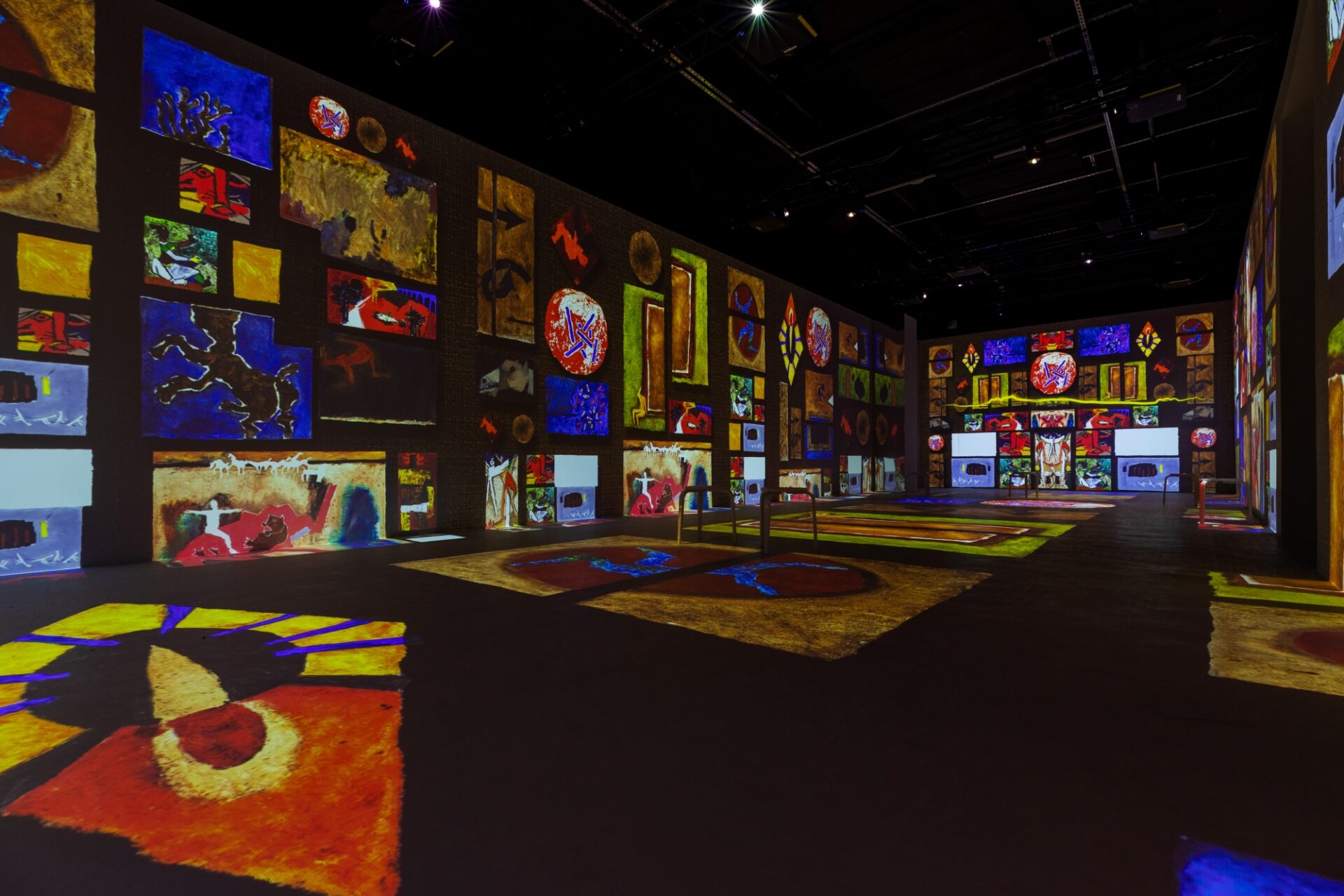Rooted Nomad: Immersive Re-Encounter with the Art of M. F. Husain
When one of India’s iconic artists, Maqbool Fida Husain (1913–2011), is brought back to us through an immersive, digitally-infused environment, a question quietly forms in the mind: Will the spectacle sharpen or dilute the artist’s truth? Roobina Karode, Director and Chief Curator of the Kiran Nadar Museum clarifies that The Rooted Nomad now showing at QM Gallery Katara takes the viewers on an immersive journey through the artists’ layered complexities. By Sindhu Nair
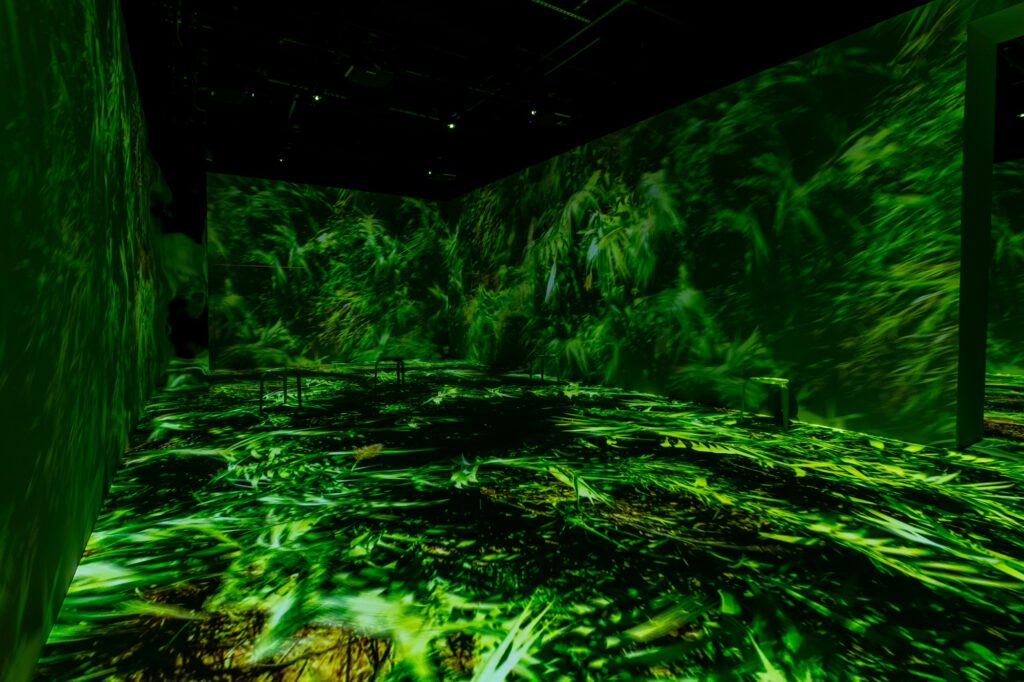
The Rooted Nomad, MF Husain exhibition at QM Gallery, Katara Building 10. The exhibition is from 28 October 2025 – 7 February 2026. Photo © Shaikha Ahmed Ali
Walking into The Rooted Nomad, a sweeping, multi-screened, digitally-layered homage to India’s most recognisable modernist, I found myself unexpectedly torn. The images rushing through the walls and the roof of the space within Katara Gallery were pulsing with an almost overwhelming digital energy. For an art lover who loves the quiet moment spent appreciating art, this seems like an intrusion on the finer senses, even though there is no arguing that the scale is rich, the experience visually magnetic and entirely enjoyable for those who love the play of graphics and pulsating imagery.
As I walk through the large immersive exhibition, a question lingers: whether in transforming M. F. Husain’s raw, insurgent energy into a luminous river of projections and motion, did the exhibition risk smoothing away the very edges that made him matter?
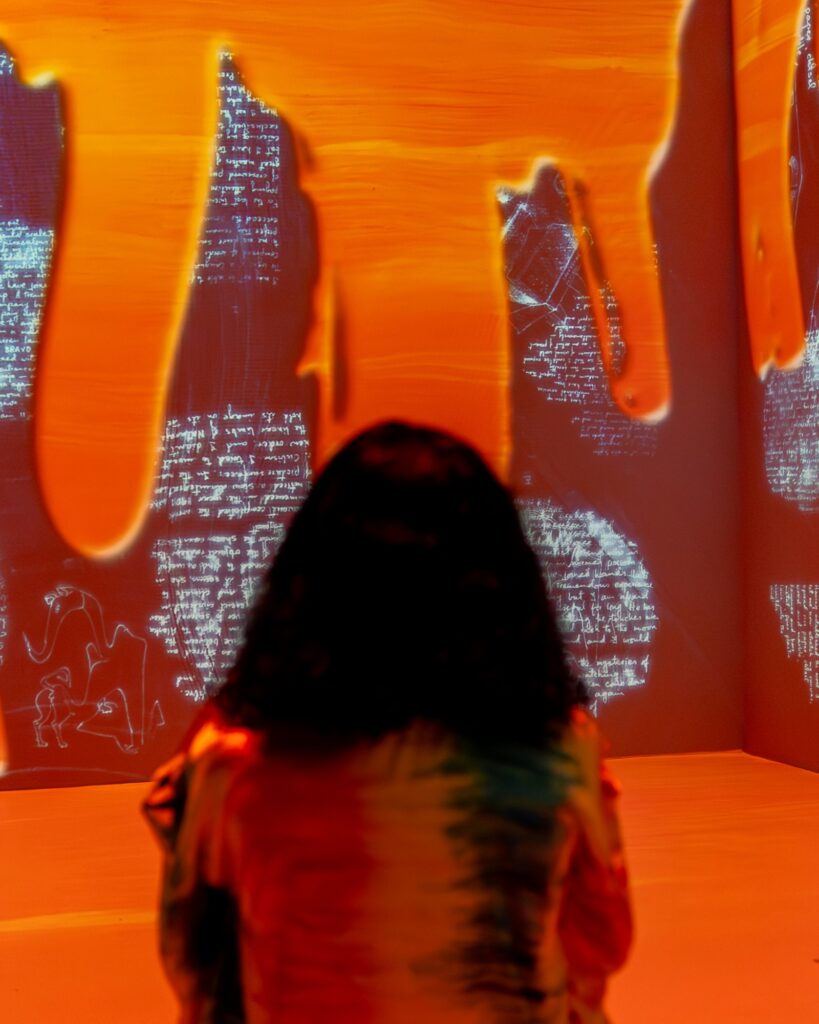
Enveloped by the art of Husain.
And yet, behind this reframing stands a curator who has lived with Husain’s complexities for decades: Roobina Karode, Director and Chief Curator of the Kiran Nadar Museum of Art (KNMA). Her vision, is far from cosmetic. It is rooted deeply, in the artist’s civilisational anchoring’s and intellectual restlessness.
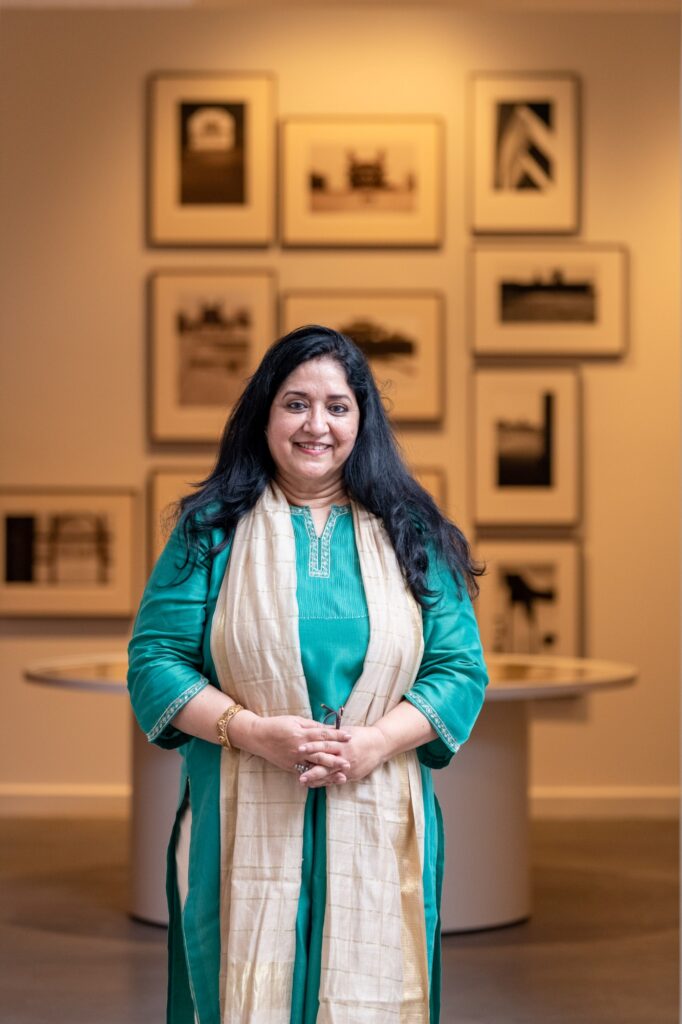
Roobina Karode, Director & Chief Curator. Picture Credits KNMA
The exhibition is in partnership with the Kiran Nadar Museum of Art (KNMA) in New Delhi, highlights more than 80 of Husain’s seminal works, complemented by a rich selection of textual and archival materials that offer deeper insight into the artist’s creative journey.
A Title That Holds a Paradox

The Rooted Nomad, MF Husain exhibition at QM Gallery, Katara Building 10. The exhibition is from 28 October 2025 – 7 February 2026. Photo © Shaikha Ahmed Ali
Roobina explains that the exhibition title itself holds Husain’s central contradiction.
“The title embodies Husain’s fundamental paradox, his deep anchorage in India’s civilisational ethos while maintaining an intellectual and physical restlessness that defined his practice,” she says.
For her, Rooted signifies his lifelong engagement with “India’s mythologies, syncretic traditions, and cultural memory, while Nomad captures the compulsive movement, from painting cinema hoardings in Bombay to his barefoot travels across India, and eventually his final years in Qatar.”
This simultaneous groundedness and displacement, she insists, was not a linear progression but a constant state of being for the artist.
What Roobina rejects outright is a conventional retrospective. “Our curatorial approach resists conventional chronological surveys or linear retrospectives, both exhausted models for such an extensively exhibited artist.”
Instead, she frames the entire exhibition as yatra, a journey, not only as a motif in Husain’s life but as an Indian civilisational condition.
“We sought to unpack how Husain processed India’s civilisational complexity through fragmentation, juxtaposition, and synthesis. The immersive format allows us to present his visual thinking through simultaneity, where myths collapse into different planes, multiple temporalities coexist, and ancient and contemporary occupy shared pictorial space. This mirrors his own compositional logic and reconfigures his practice on its own terms within postcolonial South Asian narratives,” says Roobina.
A Kaleidoscope Instead of a Catalogue

The opening in October was attended by Chairperson of Qatar Museums Her Excellency Sheikha Al Mayassa bint Hamad bin Khalifa Al Thani, Her Excellency Lolwah Al Khater, the Minister of Education and Higher Education and Vice-Chairperson of the Board of Trustees of Qatar Museums, CEO of Qatar Museums Mohammed Saad Al Rumaihi, and other distinguished guests, including Kiran Nadar, the founder of the KNMA, and Owais Husain, multimedia artist and son of M. F. Husain.
The immersive houses fragments of more than 80 works. But Roobina says that this is not a survey. “The immersive experience functions as a kaleidoscope rather than an exhaustive catalogue,” she notes.
Photographs, cinema posters, poems, archival snippets, all cohabit one moving visual field. Rather than compartmentalise his many mediums, she merges them:
“We present them as interconnected facets of a singular artistic consciousness.”
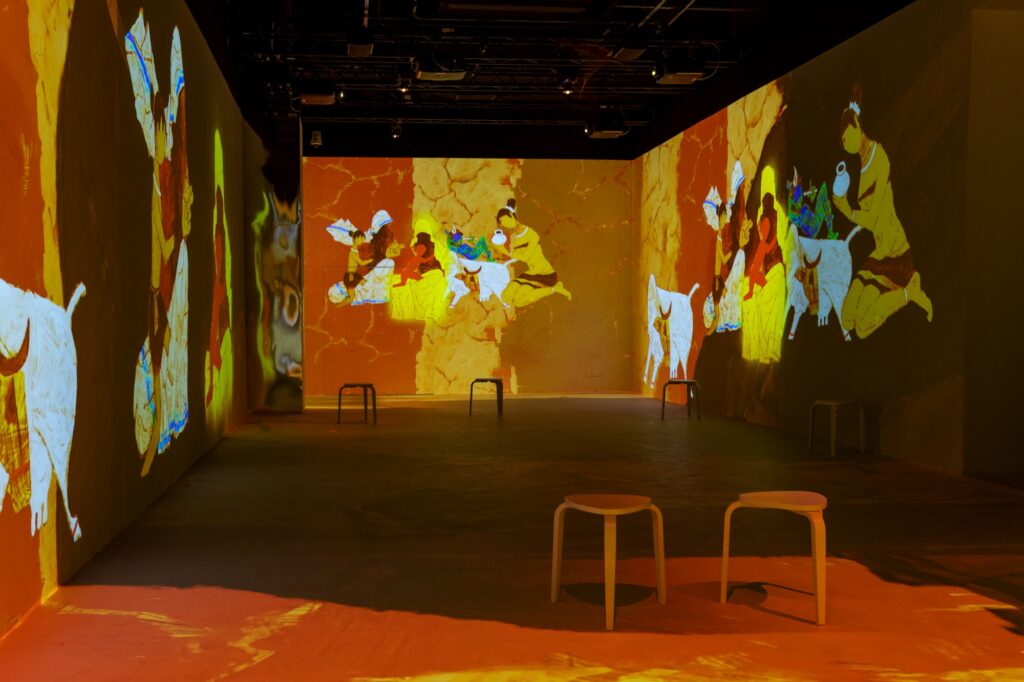
The Rooted Nomad, MF Husain exhibition at QM Gallery, Katara Building 10. The exhibition is from 28 October 2025 – 7 February 2026. Photo © Shaikha Ahmed Ali
It is here that my scepticism sharpened. While the kaleidoscope is undeniably engrossing, watching Husain’s paintings dissolve into digital abstraction made me long for the physicality of his lines, the urgency, the irreverence and the love that makes the artist, undeniably Husain.
Does the immersive risk aestheticising him too much? Roobina, however, sees the format as revelatory.
While no single canvas is displayed in its entirety, the curator identifies pieces like Untitled (Village Life) and Battle of Ganga and Yamuna as particularly telling of Husain’s dual position, chronicler of India and global modernist.
These works, she says, “encapsulate multiple storylines converging into single visual spaces,” drawing simultaneously from scroll paintings, murals, and modernist collage.
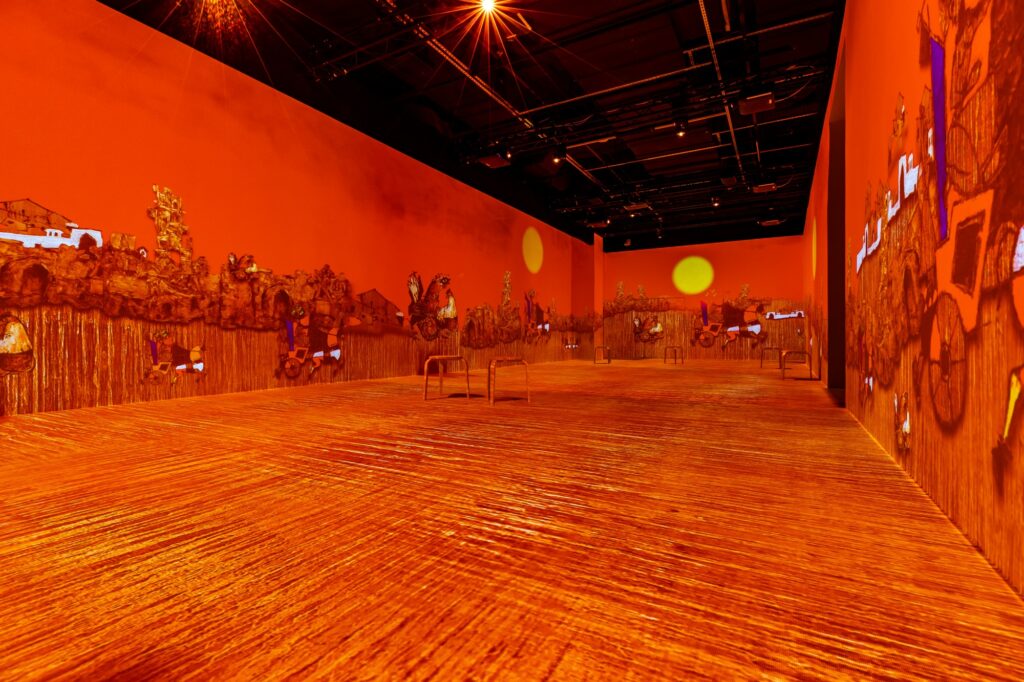
The Rooted Nomad, MF Husain exhibition at QM Gallery, Katara Building 10. The exhibition is from 28 October 2025 – 7 February 2026. Photo © Shaikha Ahmed Ali
Her insistence is firm: “It’s crucial to understand Husain’s modernism not as derivative of Western art but as a unique reflection of Indian civilizational complexity.”
Roobina positions this version of The Rooted Nomad as both evolution and shift.

The Rooted Nomad_ MF Husain exhibition at QM Gallery, Katara Building 10. The exhibition is from 28 October 2025 – 7 February 2026. Photo © Shaikha Ahmed Ali
Originally conceived for the 60th Venice Biennale in 2024, the Qatar edition is tailored to the region’s context. “It’s a continuation of KNMA’s mission to rechart South Asian modernism,” she says, but also a departure, because this iteration contains no physical artworks. It is entirely experiential, presenting Husain “through fragmentation, juxtaposition, and layered narratives.”
“The experience demonstrates that Indian modernism emerged from its own cultural soil, shaped by postcolonial nationhood, and a spiritual inheritance. This reframing is crucial for fostering newer cultural ecosystems beyond dominant Eurocentric paradigms,” she says.
A Precursor to the M.F. Husain Museum
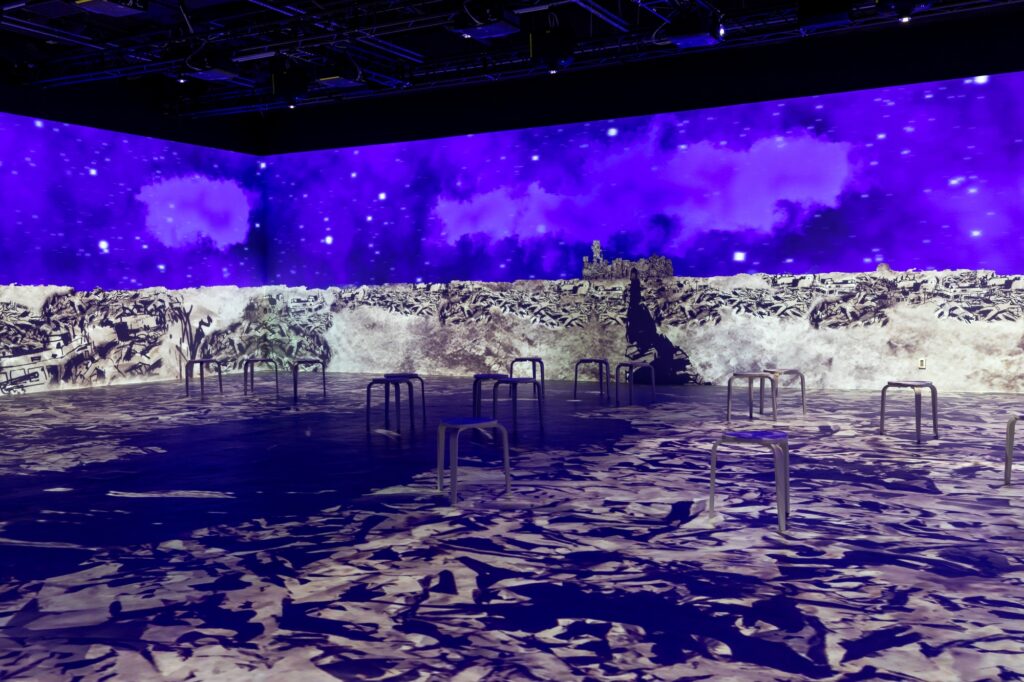
The Rooted Nomad, MF Husain exhibition at QM Gallery, Katara Building 10. The exhibition is from 28 October 2025 – 7 February 2026. Photo © Shaikha Ahmed Ali
This exhibition comes just before the opening of the M.F. Husain Museum at Qatar Foundation.
Roobina acknowledges the timing deliberately. “The Rooted Nomad serves as a meaningful precursor, almost a homecoming, given Husain’s final years in Qatar.”
Here, the museum will house the actual works; the immersive, she says, “explores the intellectual and spiritual dimensions” of his practice.
“We’ve deliberately avoided direct representation of individual artworks; instead, we present his practice through fragmentation, juxtaposition, and visual flow,” she insists. “The approaches are fundamentally different yet complementary.”
Reframing Husain Beyond the ‘Picasso of India’
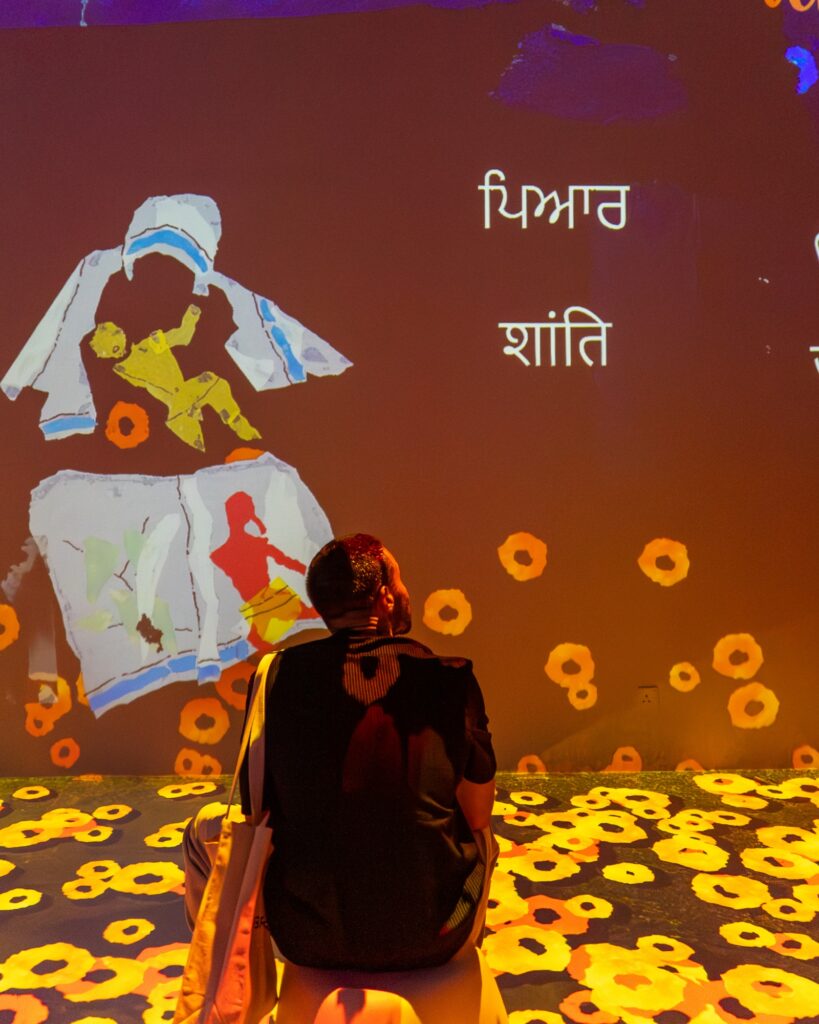
One of the most beautiful works of Husain floating around the viewers.
Roobina addresses the persistent comparison head-on, “Such comparisons risk obscuring what made Husain distinct.”
For Indian audiences, the immersive offers new perspectives on familiar symbols. For international ones, especially in Qatar, it situates Husain within South–South dialogues, not Eurocentric narratives.
“We’re reclaiming his syncretic vision… as distinctly rooted in India’s layered civilizational complexity.”
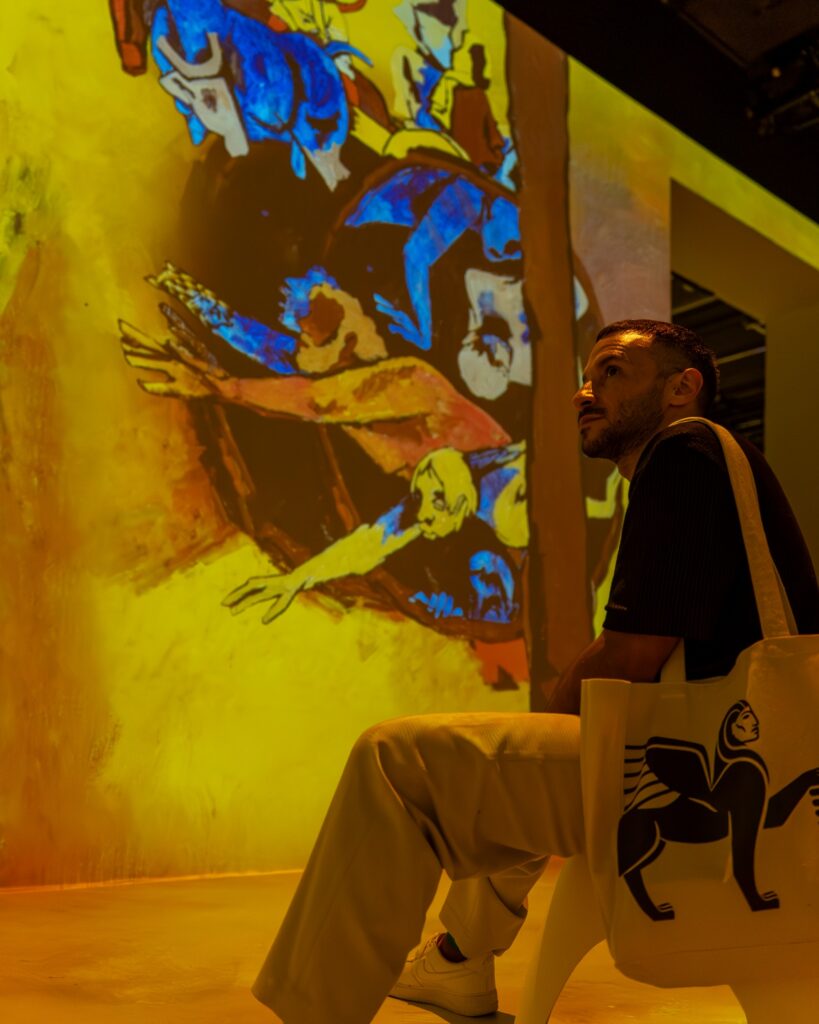
The art of Husain at QM Gallery in Katara.
Husain was both national icon and lightning rod of controversy. But in this show, Roobina intentionally sidelines biography.
“The immersive strategically emphasises artistic inquiry over biographical trivia or controversy,” she says.
There are no myths of the man, only the multiplicity of the work.
KNMA’s Larger Mission
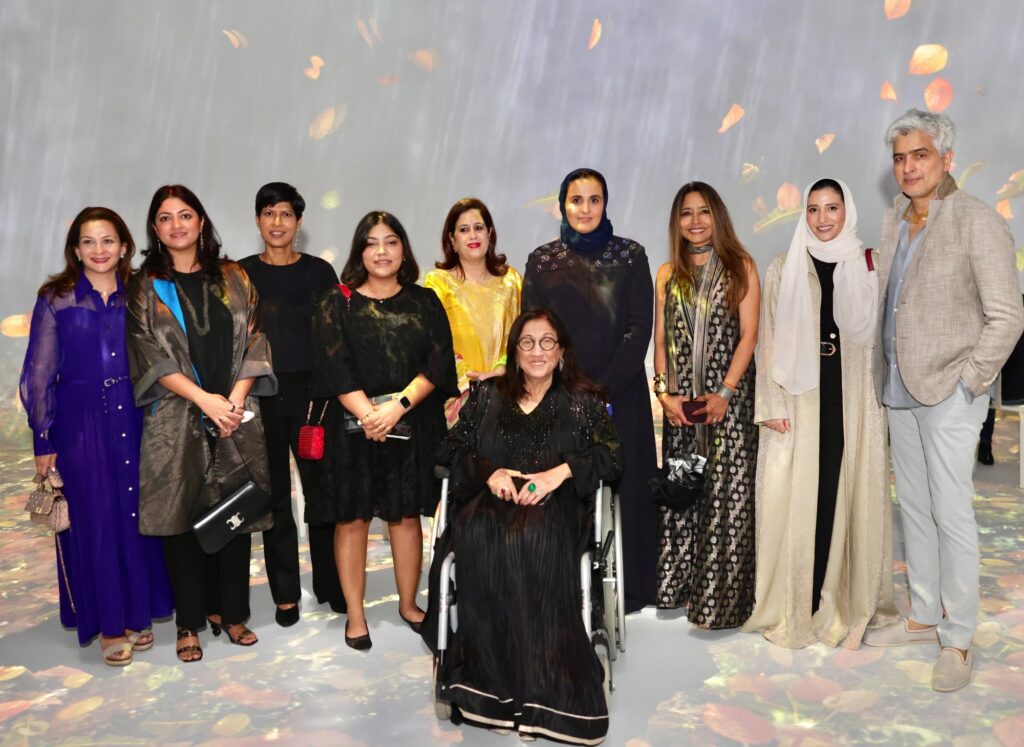
Chairperson of Qatar Museums Her Excellency Sheikha Al Mayassa bint Hamad bin Khalifa Al Thani with Sheikha Reem Al Thani Acting Deputy CEO of Exhibitions and Marketing, Director of Central Exhibitions, along with Kiran Nadar, the founder of the KNMA and other officials of KNMA and QM.
Roobina views her role as one of reshaping South Asian modernism’s global position. “We resist positioning Indian modern art as merely responsive to the West,” she asserts.
“Instead, we highlight how artists like Husain articulated unique visual vocabularies rooted in subcontinental experience, shaped by decolonisation, civilisational inheritance, and contemporary transformation. Our approach involves fostering South-South dialogues and non-Western art historical narratives, as evident in this Qatar presentation,” she says.
“We’re creating platforms for understanding Indian modernism as emerging from its own cultural soil while engaging with global currents on equal terms. This involves rigorous scholarship, innovative presentation formats like immersive experiences, and international collaborations that position South Asian artistic practices within expanded global conversations, moving beyond Eurocentric paradigms toward more inclusive, pluralistic art historical narratives,” she stresses.
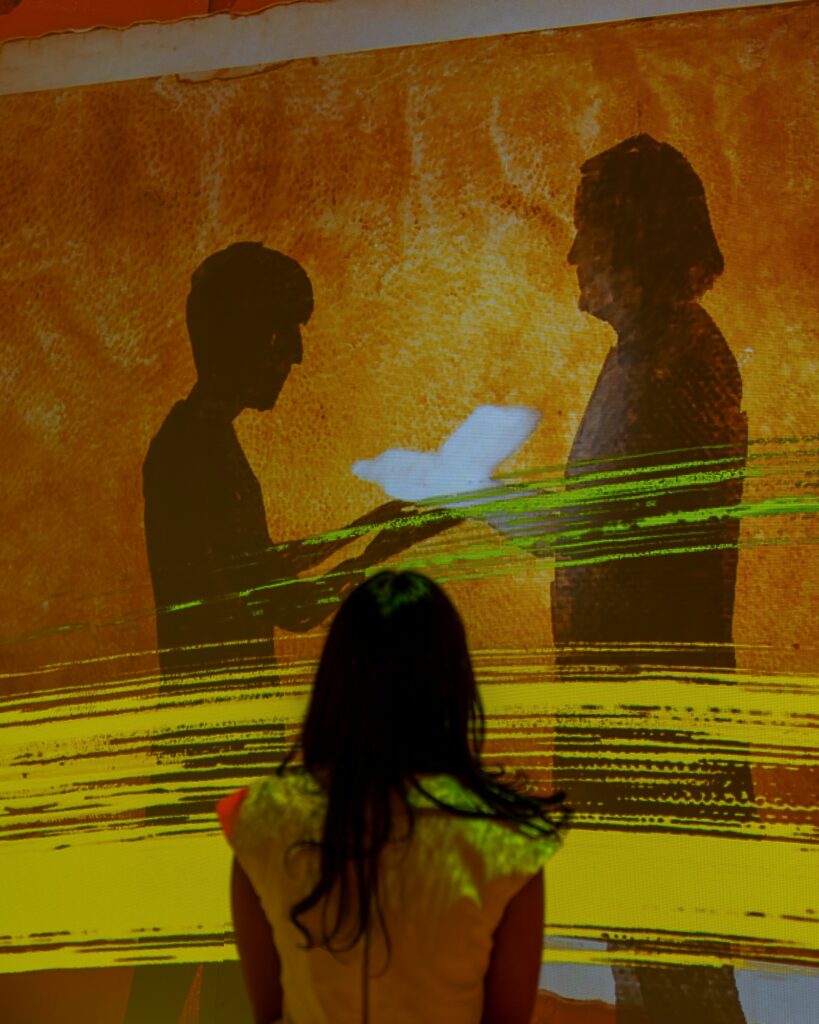
The show that introduces new spatial and sensory experiences that trace Husain’s artistic journey, shaped by memory, mythology, and a nomadic spirit.
Interestingly, even for someone who has lived with Husain’s oeuvre for years, the immersive revealed new dimensions.
“The format revealed the profound spatial and temporal complexity embedded in his visual thinking,” she admits.
“His photographs of Tamil cinema posters particularly struck me anew, how he captured layers of Indian life with deity-like film imagery overlooking everyday existence in the foreground. This visual strategy of simultaneous planes recurs throughout his practice but becomes viscerally clear through the immersive’s layered projections,” she says.
Describing the Man Beyond the Legend

The Rooted Nomad, MF Husain exhibition at QM Gallery, Katara Building 10. The exhibition is from 28 October 2025 – 7 February 2026. Photo © Shaikha Ahmed Ali
If she had to describe Husain in one phrase, she says, it would be “Restlessly grounded.”
“This captures the essential human quality beneath the artistic legacy someone perpetually driven by compulsive curiosity and the need to absorb life’s complexities, yet always tethered to deep cultural and spiritual moorings. His idiosyncratic impulse to be on streets, in roadside cafés, walking barefoot through India’s lanes wasn’t performative but genuine. For him it was a pressing need to witness and fathom the layered world around him. He remained a “people’s painter” not through pretension but authentic connection to India’s labouring masses and everyday vitality,” Roobina believes.
“This restlessness coexisted with profound rootedness in civilizational narratives, mythologies, and syncretic traditions. As a human being, Husain embodied the paradox we explore in the immersive someone who needed both anchoring and freedom, whose artistic journey was essentially a search for and absorption of essence while remaining perpetually in motion, and being curious,” she says.
For Roobina, presenting Husain in Qatar, where he lived his last years, is vital.
“It acknowledges shared narratives that connect people across geographies,” she says.
Roobina’s vision is clear and scholarly. And Husain’s work, ferocious, syncretic, unapologetically political, has a weight that digital renderings cannot fully hold.
Perhaps that is the risk and the revelation of The Rooted Nomad: it makes Husain accessible, expansive, beautifully choreographed, reaffirming his place as a true “people’s painter.”
And if this format brings him to audiences who may never walk into a traditional gallery, then it becomes a bridge worth acknowledging, because why shouldn’t the new generation experience the force of an artist as prolific, restless, and vital as him?

